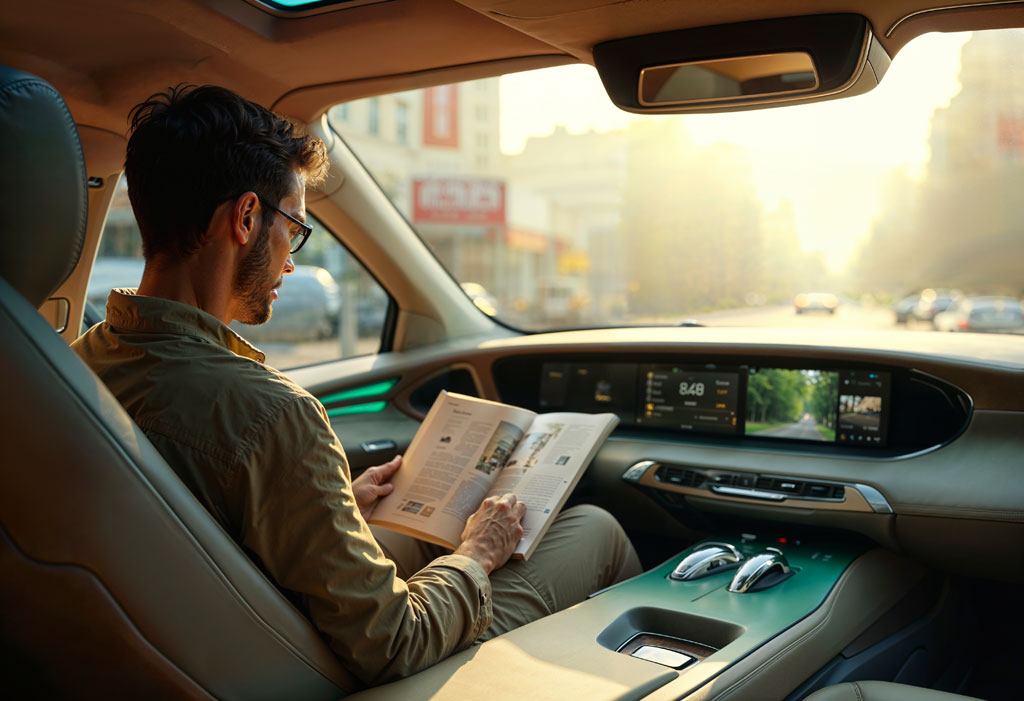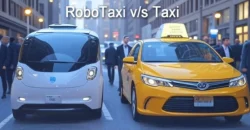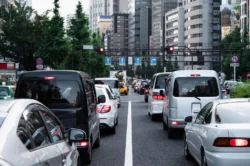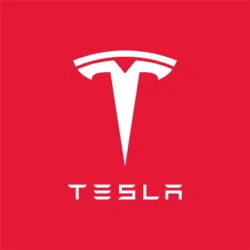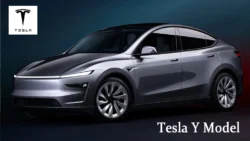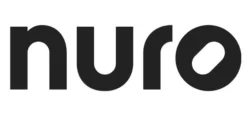The autonomous vehicle (AV) market in the United States is at a pivotal moment in 2025, driven by technological breakthroughs, evolving regulatory frameworks, and increasing consumer interest. Autonomous vehicles, particularly robotaxis, promise to transform transportation by enhancing safety, reducing traffic congestion, and offering new mobility solutions. Tesla, a global leader in electric vehicles (EVs), has been a prominent player in this space with its Full Self-Driving (FSD) technology and ambitious plans for a robotaxi service. However, Tesla faces formidable competition from companies that are already deploying fully autonomous vehicles or are poised to do so in 2025.
This article provides a comprehensive analysis of Tesla’s primary competitors in the U.S. autonomous vehicle market for 2025, focusing on Waymo (a subsidiary of Alphabet) and Zoox (a subsidiary of Amazon). These companies are leading the charge in robotaxi services, a segment where Tesla aims to compete but has not yet achieved operational success. Other players, such as Nuro, Mobileye, Ford, and Mercedes-Benz, are active in related areas like autonomous delivery or advanced driver assistance systems (ADAS), but their focus is less directly aligned with Tesla’s robotaxi ambitions. Notably, General Motors’ Cruise, once a key competitor, has scaled back its robotaxi efforts in 2025, shifting focus to ADAS for personal vehicles, reducing its relevance in this specific market segment.
The analysis covers market share, financial performance, technological advancements, regulatory challenges, and future projections for Waymo and Zoox, with a comparison to Tesla’s current position. It also includes relevant analytics to contextualize the competitive landscape, highlighting the opportunities and challenges in the U.S. AV market.
Waymo: The Leader in Operational Robotaxi Services
Waymo, a subsidiary of Alphabet, has solidified its position as the frontrunner in the U.S. autonomous vehicle market. As of 2025, Waymo operates Level 4 autonomous robotaxi services under its Waymo One brand in multiple cities, including San Francisco, Phoenix, Los Angeles, and Austin, with plans to expand to Miami and Washington, D.C. Unlike Tesla’s vision-only approach, Waymo employs a multimodal sensor suite, combining cameras, radar, and LiDAR, to navigate complex urban environments with high reliability.
Market Share
Waymo is projected to capture a low to mid single-digit percentage of the rideshare market in key U.S. cities by 2025, a significant achievement in a competitive sector dominated by Uber and Lyft. Specifically:
- In Phoenix, Waymo is expected to achieve a 4% market share, generating approximately $76 million in revenue.
- In San Francisco, a 3% market share is anticipated, with estimated revenues of $64 million.
- By April 2025, Waymo was delivering over 250,000 paid robotaxi rides per week across its operational cities, up from 200,000 in February, reflecting a tenfold increase from 2023.
These figures underscore Waymo’s growing traction in the ride-hailing market, positioning it as a direct competitor to Tesla’s planned robotaxi service.
Financial Performance
Waymo’s financial backing is robust, supported by Alphabet’s deep resources. In 2024, Waymo raised $5.6 billion in an oversubscribed investment round led by Alphabet, with participation from investors such as Andreessen Horowitz, Fidelity, and Tiger Global. This funding supports Waymo’s expansion and technological development. While specific profit margins are not publicly disclosed, Waymo’s operational scale—delivering 250,000 weekly rides—indicates a viable revenue stream. The company’s partnership with Uber in Austin and Atlanta further enhances its financial prospects by leveraging Uber’s platform to reach more customers.
Technological Advancements
Waymo’s technological prowess is evident in its sixth-generation Waymo Driver, introduced in 2025. This system is optimized for cost efficiency and enhanced capabilities, enabling fully autonomous freeway operations in Phoenix and San Francisco. Key safety metrics highlight Waymo’s edge:
- 88% fewer serious injury or worse crashes compared to human drivers.
- 79% fewer airbag deployment crashes.
- 78% fewer injury-causing crashes.
Waymo’s multimodal sensor approach, combining cameras, radar, and LiDAR, provides robust performance in diverse conditions, contrasting with Tesla’s reliance on cameras alone. The company’s extensive real-world testing, with millions of driverless miles logged, further validates its technology.
Regulatory Challenges
Waymo has demonstrated expertise in navigating U.S. regulatory landscapes, securing permits for driverless operations in multiple states. Its expansion into new cities like Miami and Washington, D.C., suggests successful collaboration with local authorities. Partnerships with Uber and proactive engagement with public safety officials, including training sessions for first responders, have facilitated regulatory approval. However, ongoing federal scrutiny of autonomous vehicles, as seen in investigations of Tesla’s software, could pose future challenges for the industry as a whole.
Future Projections
Waymo’s roadmap for 2025 and beyond is ambitious. The company plans to:
- Expand Waymo One services to Miami and Washington, D.C., in 2025.
- Increase its fleet size from over 1,500 vehicles in 2025 to 3,500 by 2026, incorporating new models like the Hyundai IONIQ 5 and Zeekr RTs.
- Enhance its technology to support broader geographic coverage and more complex driving scenarios.
Waymo’s mission emphasizes inclusive mobility and sustainability, aiming to reduce the 42,514 road deaths reported in the U.S. in 2022. With Alphabet’s backing and a proven operational model, Waymo is well-positioned to maintain its leadership in the U.S. AV market.
| Metric | Waymo (2025) |
|---|---|
| Market Share (Phoenix) | 4% (~$76M revenue) |
| Market Share (San Francisco) | 3% (~$64M revenue) |
| Weekly Rides | 250,000+ |
| Funding | $5.6B (2024 round) |
| Fleet Size | 1,500+ (2025), 3,500 planned by 2026 |
| Autonomy Level | Level 4 |
| Safety Impact | 88% fewer serious injury crashes vs. human drivers |
Zoox: Amazon’s Ambitious Entry into Robotaxis
Zoox, acquired by Amazon in 2020, is an emerging competitor in the U.S. autonomous vehicle market. Unlike Waymo, which retrofits existing vehicles, Zoox is developing a bespoke, bi-directional battery-electric vehicle designed specifically for autonomy. This unique approach addresses the limitations of retrofitted systems, positioning Zoox as a potential disruptor in the robotaxi space. As of 2025, Zoox is preparing for a commercial rollout in the U.S., with plans to launch public rides in Las Vegas and San Francisco.
Market Share
Zoox’s market share in 2025 is not yet quantified, as the company has not launched commercial services. However, its planned launches in Las Vegas and San Francisco, coupled with a new production facility, suggest potential for rapid growth. Zoox has deployed approximately two dozen test vehicles across six U.S. cities, laying the groundwork for scaling its operations. The company’s focus on urban mobility aligns with the growing demand for ride-hailing services, positioning it to compete with Waymo and Tesla’s future robotaxi offerings.
Financial Performance
Zoox has benefited from significant financial support, raising $990 million over six funding rounds before its acquisition by Amazon for $1.2 billion in 2020. As a subsidiary of Amazon, Zoox has access to substantial resources, enabling investment in production and technology development. Specific financial performance metrics for 2025 are not publicly available, but Amazon’s commitment to Zoox’s expansion, including a new production facility, indicates confidence in its long-term potential.
Technological Advancements
Zoox’s purpose-built robotaxi is a standout feature, designed to optimize autonomous mobility. The vehicle is symmetrical and bi-directional, eliminating the need for traditional driving controls like steering wheels or pedals. This design enhances passenger comfort and safety, addressing the unique challenges of urban ride-hailing. Zoox’s self-driving system, tested in cities like San Francisco and Las Vegas, leverages advanced robotics and AI. The company’s acquisition of Strio AI in 2022 further bolstered its technological capabilities.
Regulatory Challenges
Zoox has secured permits for driverless testing in California, a critical step toward commercial operations. Its expansion plans for Las Vegas and San Francisco suggest progress in navigating state and local regulations. However, the bespoke nature of Zoox’s vehicle may require additional regulatory scrutiny compared to retrofitted systems. The company’s proactive engagement with regulators, as evidenced by its testing permits, positions it well to address these challenges.
Future Projections
Zoox’s roadmap for 2025 includes:
- Launching public rides in Las Vegas in 2025, followed by San Francisco.
- Opening a new production facility in California’s Bay Area to scale production from dozens to hundreds, and eventually thousands, of robotaxis.
- Integrating its technology with Amazon’s broader ecosystem, potentially including delivery services.
With Amazon’s backing, Zoox is poised to become a significant player in the U.S. robotaxi market, challenging Waymo and Tesla’s ambitions.
| Metric | Zoox (2025) |
|---|---|
| Market Share | Not quantified; planned launches in Las Vegas and San Francisco |
| Funding | $990M pre-acquisition; $1.2B acquisition by Amazon (2020) |
| Fleet Size | ~24 test vehicles; scaling to hundreds/thousands planned |
| Autonomy Level | Level 4 (in testing) |
| Key Milestone | Public rides planned for Las Vegas in 2025 |
Tesla: A Leader in EVs, but Lagging in Full Autonomy
Tesla remains a dominant force in the electric vehicle market, with its FSD technology being one of the most advanced ADAS systems available to consumers. However, as of 2025, Tesla’s FSD is classified as Level 2 autonomy, requiring constant driver supervision. This places Tesla behind Waymo and Zoox, which are operating or testing at Level 4 in specific areas. Tesla’s vision-only approach, relying solely on cameras and AI, is innovative but controversial, with critics citing limitations in adverse weather conditions or complex urban scenarios.
Market Position
Tesla has not yet launched a robotaxi service, despite CEO Elon Musk’s ambitious targets. The company’s FSD software, priced at $8,000, includes features like traffic light and stop sign control, autosteer, and smart summon, but it remains a driver-assist system rather than a fully autonomous solution. Tesla’s global EV sales declined in 2024 compared to 2023, highlighting the need for new growth drivers like autonomous vehicles. The company’s planned robotaxi service, expected to start with 10 to 20 vehicles in Austin, Texas, in 2025, is a high-risk strategy dependent on achieving reliable self-driving technology.
Technological Approach
Tesla’s reliance on a vision-only system, powered by eight cameras and a deep learning neural network, is unique in the industry. While this approach reduces hardware costs and enables scalability through over-the-air updates, it faces challenges in achieving the robustness required for Level 4 or 5 autonomy. Competitors like Waymo and Zoox use multimodal sensors, which are considered more reliable in diverse conditions. Tesla’s proprietary AI chips and extensive data collection from its fleet provide a competitive edge, but the company is under federal investigation for its autonomous software, raising safety concerns.
Regulatory and Public Perception Challenges
Tesla faces significant regulatory hurdles, including a federal investigation by the National Highway Traffic Safety Administration (NHTSA) into its FSD software. The company must provide detailed plans for its robotaxi rollout to gain regulatory approval. Public perception is another challenge, with only 13% of U.S. drivers trusting self-driving vehicles in 2025, according to AAA. Tesla’s marketing of FSD as “Full Self-Driving” has drawn criticism for overstating its capabilities, potentially eroding consumer trust.
| Metric | Tesla (2025) |
|---|---|
| Market Share (Robotaxi) | None; robotaxi service not yet launched |
| FSD Price | $8,000 |
| Autonomy Level | Level 2 (FSD Supervised) |
| Planned Robotaxi Fleet | 10–20 vehicles in Austin, Texas (2025) |
| Key Challenge | Federal investigation into FSD software |
Comparative Analytics
The U.S. autonomous vehicle market is projected to be a significant segment of the global AV market, expected to reach $428.3 billion in 2025. The following analytics highlight the competitive dynamics between Waymo, Zoox, and Tesla:
- Market Penetration: Waymo leads with operational robotaxi services in multiple cities, delivering over 250,000 weekly rides. Zoox is poised to enter the market with launches in Las Vegas and San Francisco, while Tesla’s robotaxi service remains in development, with no operational presence in 2025.
- Financial Backing: Waymo and Zoox benefit from substantial investments by Alphabet ($5.6 billion in 2024) and Amazon ($1.2 billion acquisition in 2020), respectively. Tesla’s financial strength, driven by its EV business, supports its AV efforts, but the company faces pressure to deliver on its robotaxi promises.
- Technological Approaches: Waymo’s multimodal sensor system (cameras, radar, LiDAR) and Zoox’s purpose-built vehicle contrast with Tesla’s vision-only approach. The debate over sensor strategies remains unresolved, with Waymo and Zoox’s systems considered more robust for Level 4 autonomy.
- Regulatory Success: Waymo has a proven track record of securing regulatory approvals, while Zoox is making steady progress. Tesla’s regulatory challenges, including federal investigations, could delay its robotaxi rollout.
- Consumer Trust: Only 13% of U.S. drivers trust self-driving vehicles in 2025, up from 9% in 2024, according to AAA. This low trust level affects all players but is particularly challenging for Tesla, given its high-profile safety concerns.
The following table summarizes the competitive landscape:
| Company | Autonomy Level | Operational Cities (2025) | Market Share (Rideshare) | Financial Backing | Key Challenge |
|---|---|---|---|---|---|
| Waymo | Level 4 | SF, Phoenix, LA, Austin | 3–4% in key cities | $5.6B (Alphabet) | Scaling operations |
| Zoox | Level 4 (testing) | Las Vegas, SF (planned) | Not quantified | $1.2B (Amazon) | Production scaling |
| Tesla | Level 2 | None (robotaxi planned) | None | EV revenue | Regulatory scrutiny |
Market Trends and Challenges
The U.S. autonomous vehicle market is shaped by several trends and challenges:
- Market Growth: The global AV market is projected to grow from $282.2 billion in 2024 to $428.3 billion in 2025, with the U.S. as a key hub due to its technological innovation and regulatory frameworks.
- Consumer Trust: Despite technological advancements, consumer trust remains low, with 6 in 10 U.S. drivers expressing fear of self-driving vehicles. Enhancing safety and transparency is critical for market adoption.
- Regulatory Developments: California’s allowance for up to 2,500 vehicles without traditional controls (e.g., steering wheels) in 2025 supports AV deployment. However, federal oversight and varying state regulations create complexity.
- Technological Progress: Partially autonomous vehicles (Level 3) are expected to comprise 10% of new vehicle sales by 2030, with Level 3 systems becoming more common in 2025. Fully autonomous robotaxis (Level 4 and above) remain a niche but growing segment.
Conclusion
In 2025, the U.S. autonomous vehicle market is a battleground for innovation, with Waymo and Zoox emerging as Tesla’s primary competitors in the robotaxi space. Waymo’s operational success, with over 250,000 weekly rides and a robust technological platform, positions it as the market leader. Zoox, backed by Amazon, is set to challenge Waymo with its purpose-built robotaxi and planned launches in Las Vegas and San Francisco. Tesla, while a pioneer in EVs, lags in achieving full autonomy, with its FSD system still at Level 2 and its robotaxi service not yet operational.
The competition is far from over, with regulatory clarity, consumer trust, and technological advancements shaping the future. Waymo’s multimodal approach and Zoox’s innovative vehicle design offer distinct advantages over Tesla’s vision-only strategy, but Tesla’s scalability and data-driven AI could close the gap if regulatory and technical challenges are addressed. As the U.S. moves toward a future of autonomous mobility, the interplay of these factors will determine which company emerges as the dominant force.
